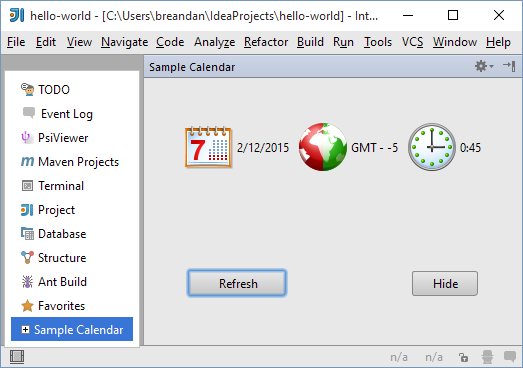Tool Windows
Tool windows are child windows of the IDE used to display information. These windows generally have their own toolbars (referred to as tool window bars) along the outer edges of the main window containing one or more tool window buttons, which activate panels displayed on the left, bottom and right sides of the main IDE window. For detailed information about tool windows, please see IntelliJ IDEA Web Help and Tool window topic in IntelliJ Platform UI Guidelines.
Each side contains two tool window groups, the primary and the secondary one, and only one tool window from each group can be active at a time.
Each tool window can show multiple tabs (or "contents", as they are called in the API). For example, the Run tool window displays a tab for each active run configuration, and the Changes/Version Control tool window displays a fixed set of tabs depending on the version control system used in the project.
There are two main scenarios for the use of tool windows in a plugin. Using declarative setup, a tool window button is always visible, and the user can activate it and interact with the plugin functionality at any time. Alternatively, using programmatic setup, the tool window is created to show the results of a specific operation, and can be closed by the user after the operation is completed.
Project-level topic ToolWindowManagerListener allows listening to tool window (un-)registering/show events (see Listeners).
Declarative Setup
The tool window is registered in plugin.xml using the com.intellij.toolWindow extension point. The extension point attributes specify all the data which is necessary to display the tool window button:
The
idof the tool window - corresponds to the text displayed on the tool window button. To provide a localized text, specify matchingtoolwindow.stripe.[id]message key (escape spaces with_) in your message bundle (code insight supported in 2020.3 and later).The
iconto display on the tool window button (13x13 pixels, grey and monochromatic; see Tool window in IntelliJ Platform UI Guidelines and Working with Icons and Images)The
anchor, meaning the side of the screen on which the tool window is displayed ("left" (default), "right" or "bottom")The
secondaryattribute, specifying whether the tool window is displayed in the primary or the secondary group
In addition to that, specify the factoryClass attribute - the name of a class implementing the ToolWindowFactory interface. When the user clicks on the tool window button, the createToolWindowContent() method of the factory class is called, and initializes the UI of the tool window. This procedure ensures that unused tool windows don't cause any overhead in startup time or memory usage: if a user does not interact with the tool window, no plugin code will be loaded or executed.
If the tool window of a plugin doesn't need to be displayed for all projects:
Implement the isApplicable(Project) method.
Specify the conditionClass attribute in plugin.xml with a class implementing Condition<Project> (can be the same class as the ToolWindowFactory implementation).
Note, the condition is evaluated only once when the project is loaded. To show and hide a tool window dynamically while the user is working with the project, use programmatic setup for tool window registration.
Programmatic Setup
The second method involves simply calling ToolWindowManager.registerToolWindow() from the plugin code. The method has multiple overloads that can be used depending on the task. When using an overload that takes a component, the component becomes the first content (tab) displayed in the tool window.
Contents (Tabs)
Displaying the contents of many tool windows requires access to indexes. Because of that, tool windows are normally disabled while building indexes unless the ToolWindowFactory implements DumbAware. For programmatic setup, parameter canWorkInDumbMode must be set to true in calls to registerToolWindow().
As mentioned previously, tool windows can contain multiple contents (tabs). To manage the contents of a tool window, call ToolWindow.getContentManager(). To add a content (tab), first create it by calling ContentManager.getFactory().createContent(), and then to add it to the tool window using ContentManager.addContent(). Use Content.setDisposer() to register associated Disposable (see Disposer and Disposable).
Closing Tabs
A plugin can control whether the user is allowed to close tabs either globally or on a per-content basis. The former is done by passing the canCloseContents parameter to the registerToolWindow() function, or by specifying canCloseContents="true" in plugin.xml. The default value is false; calling setClosable(true) on ContentManager content will be ignored unless canCloseContents is explicitly set. If closing tabs is enabled in general, a plugin can disable closing of specific tabs by calling Content.setCloseable(false).
Sample Plugin
To clarify how to develop plugins that create tool windows, consider the toolWindow sample plugin available in the code samples.
See Code Samples on how to set up and run the plugin.
This plugin creates the Sample Calendar tool window that displays the system date, time and time zone. When opened, this tool window is similar to the following screen:
